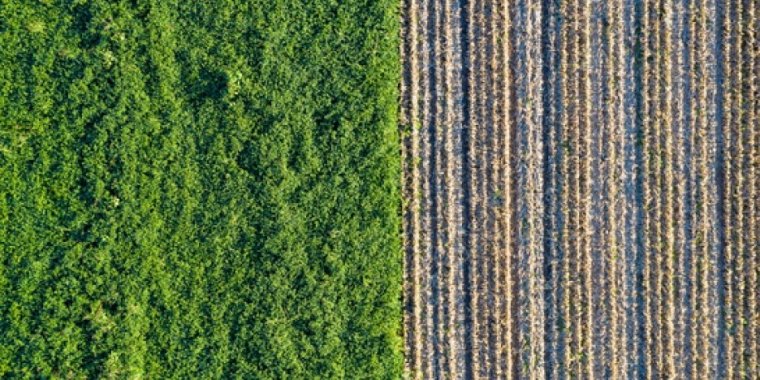| News / Science News |
Capturing carbon with crops, trees and bioenergy
An integrated approach to land management practices in the U.S. can reduce carbon dioxide in the atmosphere far more than earlier estimates based on separate approaches, Michigan State University scientists say.

Aerial view of a cultivated field on the left for biomass and on the right for corn. Photo: Mauro Tandoi/Unsplash
"Using only land management or bioenergy in an either-or scenario turns out to be short-sighted," said Phil Robertson of the Kellogg Biological Station Long-Term Ecological Research site. "When we combine them, we find potential carbon dioxide storage capacity levels that neither approach alone can attain."
Scientists are finding that combining those practices might reduce carbon dioxide levels, which is critical for keeping the global temperature increase below 2 degrees Celsius by year 2100.
"This work has the potential to substantially improve management by incorporating data from basic ecological research," said Francisco (Paco) Moore, a program director in NSF's Division of Environmental Biology.
Land management that naturally captures more carbon dioxide in soils, trees and natural areas has long been known for its potential to curb emissions.
Bioenergy uses plant-based fuels to run cars on ethanol or electricity, and during its production the carbon dioxide it releases can be geologically stored or sequestered below ground.
Robertson and colleagues at Colorado State University and the University of Aberdeen in the U.K. assigned management practices known to reduce or capture greenhouse gases in cropland, grazing lands and forests to different portions of the U.S. landscape.
Practices included reforestation, forest and grassland management, cropland practices like cover crops and no-till, and bioenergy production on lands not used to grow food. Many of these practices have additional benefits including improving soil health, biodiversity and water quality.
"We knew there might be some advantage to an integrated approach, but we were surprised at just how large it could be," Robertson said.
"A 50% increase in the capacity for changes in land management to capture carbon dioxide is big, especially because we currently lack other affordable options for doing so." (U.S. National Science Foundation)
YOU MAY ALSO LIKE





